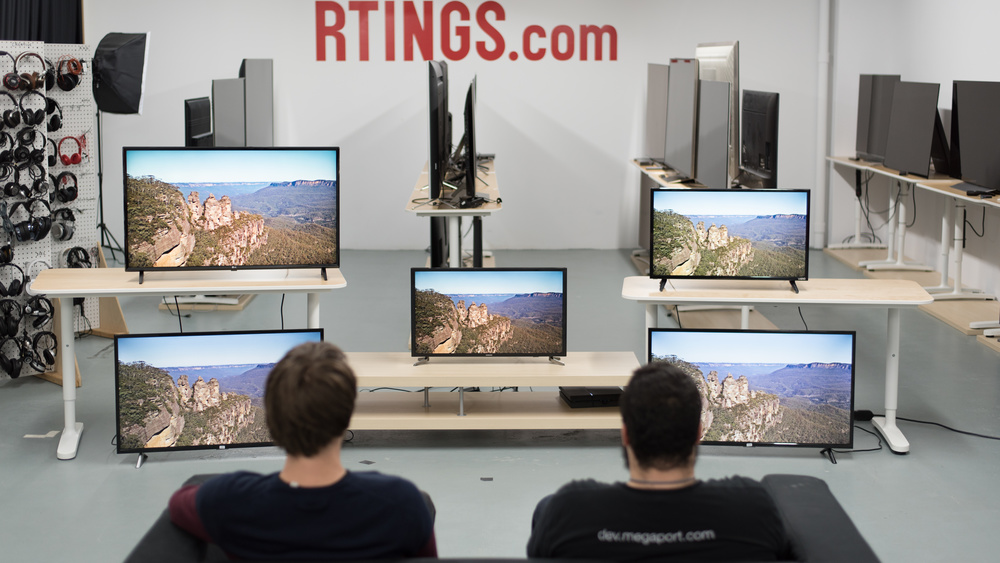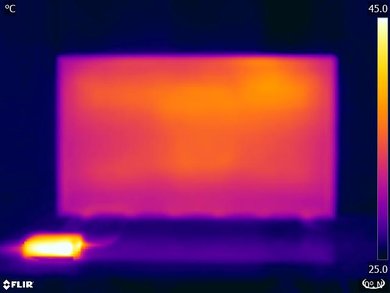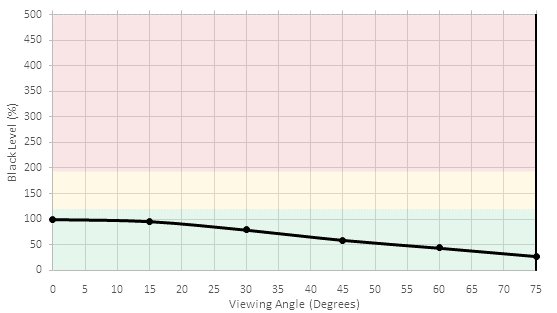The Samsung M5300 is a full-HD TV with disappointing picture quality. When viewed in a dark room, the blacks appear gray and blotchy. In a brighter room, this isn't an issue but the motion handling is sub-par and there are no features to improve the picture quality further such as local dimming.
Our Verdict
Below average TV for mixed usage. Movie performance is bad due to poor black uniformity and low native contrast ratio. Decent for sports and TV shows in a bright room as reflection handling is fine and image remains quite accurate when viewed at an angle.
-
Image remains accurate when viewed at an angle
-
Picture quality is below average
-
Blacks appear gray and blotchy in a dark room
Poor choice for watching movies in a dark room. Low native contrast ratio results in blacks that appear gray, and uniformity is poor. Can't play movies without some minor judder.
Decent for watching TV in a bright room. Picture quality is below average but reflection handling is decent and image remains accurate when viewed at an angle. The smart features are good for casual watching too.
Decent TV for sports. Motion blur is quite low which is good and fast action is handled well. Unfortunately, the picture quality is below average, but the image remains accurate when viewed at an angle.
Slightly below average for gaming. Motion blur is good so fast-paced games are handled well. Input lag is good enough for most people but may disappoint competitive gamers. Only supports basic resolutions and picture quality is below average.
The Samsung M5300 doesn't support HDR, and can't produce a wide color gamut or produce bright highlights.
Doesn't support HDR gaming.
Below average choice as PC monitor. Motion handling is good, and input lag is good but may not feel as responsive as some other TVs. Picture quality is below average but the image remains accurate when viewed from up close.
- 6.3 Mixed Usage
- 5.1 Movies
- 7.4 TV Shows
- 7.4 Sports
- 6.8 Video Games
- 3.8 HDR Movies
- 4.0 HDR Gaming
- 7.0 PC Monitor
Changelog
- Updated Jan 25, 2019: We have received a report that larger sizes have a VA panel, but we are not sure. The review remains valid, but we expect VA panels to have better contrast ratio at the expense of worse viewing angles.
- Updated Mar 12, 2018: Converted to Test Bench 1.2.
- Updated Oct 23, 2017: Review published.
- Updated Oct 21, 2017: Early access published.
- Updated Oct 20, 2017: Our testers have started testing this product.
Check Price
Differences Between Sizes And Variants
We tested the 32" (UN32M5300) version XA01. For the most part, we expect our review to be valid for the 40" version (UN40M5300), 43" version (UN43M5300), 49" version (UN49M5300) and 50" version (UN50M5300).
If someone comes across a different type of panel or if their Samsung M5300 doesn't correspond to our review, let us know and we will update the review.
| Size | Model | Warehouse | Panel* |
| 32" | UN32M5300 | UN32M530D | IPS |
| 40" | UN40M5300 | UN40M530D | VA |
| 43" | UN43M5300 | UN43M530D | VA |
| 49'' | UN49M5300 | UN49M530D | VA |
| 50'' | UN50M5300 | UN50M530D | VA |
*Update 1/25/2019: We have received reports that the larger models have a VA panel but we are not sure. The models with VA panel should have better contrast ratio but narrower viewing angles.
Compared To Other TVs

The Samsung M5300 is a budget 1080p TV, however, it faces tough competition which is often available at a lower price. See our recommendations for the best TVs under $300 and the best budget TVs.
The Samsung MU6300 is much better than the Samsung M5300. The MU6300 has a VA type panel (except the 43" model) and has much better dark room performance thanks to the higher contrast ratio and much better black uniformity. The Samsung M5300 has an IPS display which is better for bright room performance and has wider viewing angles. The MU6300 supports HDR and has a higher resolution 4k display as well as lower input lag for games.
The Samsung M5300 is somewhat better than the TCL D100 and is more suitable for a wide room as it has an IPS Panel with better viewing angles. The TCL D100 has a VA panel and thus better contrast and better black uniformity so it can display better blacks is a dark room. The Samsung M5300 is a smart TV whereas the TCL D100 has no smart platform and you need to use an external device so that you get smart features. Finally, the Samsung M5300 has a motion interpolation feature for the fans of the soap opera effect.
The Samsung M5300 is better than the LG LJ5500. The Samsung M5300 has better reflection handling and a wider viewing angle, so it will better suit a wider variety of rooms. The M5300 also has an optional motion interpolation feature which the LJ5500 lacks. This optional feature can clear up motion but introduces some artifacts. The LG LJ5500 is better able to remove judder from 24p sources, which the M5300 can't do.
The Samsung M5300 is a better TV than the Vizio D Series 1080p 2017. The Samsung M5300 has better motion interpolation to handle those fast-moving scenes in movies and when used as a PC monitor can display properly a 1080p @ 60Hz @ 4:4:4 signal. The Samsung M5300 has marginally better SDR peak brightness that is apparent when watching TV shows in brighter rooms and slightly better contrast ratio and black uniformity to improve picture quality when watching movies or HDR content in a dark room.
The Samsung M5300 is better than the Samsung M4500, unless you use it mostly in a dark room. The M5300 has an IPS panel, which is better suited for a wide viewing area in a brighter room. The M4500 has a VA panel, which has a worse viewing angle but much better native contrast. The M5300 also has a higher native resolution and is available in larger sizes, as well as less input lag for gamers.
The Samsung M5300 is marginally better than the Samsung N5300. The M5300 has a lower input lag that is great if you play games and a motion interpolation feature for the soap opera effect fans. On the other hand, the N5300 has better SDR peak brightness which is great if your TV room is slightly brighter and also a better gray uniformity, so you can enjoy watching sports without dirty screen effect.
The Samsung M4500 and the Hisense H4F have different panel types, each with advantages and disadvantages. The M4500 has a VA panel and can display deeper blacks in a dark room, while the Hisense has wider viewing angles, which is good if you often walk around while you watch TV. The Hisense is also available in more sizes and has a lower input lag, which is great for gamers.
Test Results
The design of the Samsung M5300 is decent. It looks fairly basic and won't be the centerpiece of a room, with an all-plastic exterior. The stand is wide and may not fit on smaller tables but feels quite stable. The TV is quite thick and may stick out from the wall a bit if mounted, and doesn't provide any cable management.
The Samsung M5300 has a below average contrast ratio and when viewed in a dark room, blacks look more grayish than really black. When set in a room with a good lighting, the ambient light helps to negate the low contrast ratio effect and the overall picture quality looks better. This is very typical of most IPS TVs out there.
The Samsung M5300 does not have a local dimming feature. The video is for reference only.
Decent brightness, good enough for a moderately lit room but may appear dim in a bright room. The TV is more dim near the edges, where the real scene brightness is measured, as visible in the TV's gray uniformity photo. The TV's CE dimming dims very dark scenes like our 2% white window in an attempt to make the scene darker, but it unfortunately dims the highlights as well.
HDR is not supported.
The M5300 has a decent gray uniformity with some dirty screen effect. The center of the screen is a bit brighter than the sides and some darker vertical bands are also visible on each side of the center bright spots.
Looking at our 5% gray test picture, nothing bad can be really noticed, which is good, especially for movies with darker scenes.
Decent viewing angle, even for an IPS panel, and far better than all VA TVs. Blacks stay black, and colors and brightness remain decent when the TV is viewed at moderate angles. This TV would be a good choice for a room where people often sit to the side of the TV and view it at an angle.
Black uniformity of this Samsung TV is disappointing, but this is not surprising for an IPS TV, which tends to always have worse black uniformity than most VA TVs. This is visually more striking because of the low contrast ratio. With the M5300, the most visually noticeable part is the flashlighting near the edges of the screen. The center of the screen is also a bit brighter than the rest of the screen, and it closely matches the brighter zone that we already noticed on the 50% gray uniformity.
The M5300 is decent at handling reflections. It has a semi-gloss finish which diffuses reflections across the screen and reduces their intensity but does result in a larger reflection footprint. This is fine for most rooms but may be an issue in bright rooms.
Before calibration and when set on the most accurate picture mode and color temperature, in this case, the 'Movie' picture mode and the 'Warm1' color temperature, the M5300 has a good overall accuracy. The white balance dE is just a bit over 3, which at this dE, the inaccuracy is noticeable to enthusiasts, but for most people should not be a problem. For the color accuracy, the dE is only of 2.55, which should only be noticeable to professionals who are used to working with calibrated TVs.
As for the gamma, it is hovering a bit over our desire gamma of 2.2 with only a little bump in the darker IRE, which could make dark scenes a bit darker than what they normally should be.
Note here that we did use the 'Warm1' on this TV, but this is exceptional, as normally, 'Warm2' give us better result than 'Warm1', which is a bit too colder.
After calibration, the accuracy of the M5300 is excellent. The white balance dE is only of 0.21 which is almost perfect since, at this level of accuracy, the imperfections are not noticeable. On the color side, the color dE was brought down to 1.78, which is better than before calibration and should be good for most people, except maybe professionals who might be able to notice slight imperfections in the reds and blues. As for gamma, the correction done on the white balance took care of the little bump and flattened the gamma curve.
You can see our recommended settings here.
Standard color gamut, good enough for SDR content using the Rec 709 color gamut. This gamut wouldn't be good for HDR content, but this TV doesn't support HDR anyway.
Poor HDR color volume, but this is expected of an SDR-only TV. The volume should be good enough for most SDR content, but the TV makes dark colors brighter than they should be because of the TV's mediocre contrast ratio.
The Samsung M5300 is great at displaying our gradient test image and surprisingly, 8-bit banding is not visible. Some little imperfections can be seen in the darker colors, but this is not really problematic for normal content and is fairly typical of other Samsung TV we have tested before.
We don't expect IPS panels to experience permanent image retention, as the IPS panel in our long-term test appears immune.
Very good low motion blur, good enough for watching fast moving content. The pixel response time is fairly fast, leading to only a short trail following moving objects. Most of the blur in the picture is due to the image flicker. The TV applies just a bit of overdrive to make the response time faster without adding much visible overshoot, which is good.
Poor image flicker. The TV only dims the backlight by using PWM dimming, which introduces more flicker the dimmer the backlight. While this flicker does reduce persistence blur, it also produces the double image artifacts visible in the motion blur picture.
While the TV does have a BFI setting to reduce persistence blur (the 'LED Clear Motion' setting), all it does on this TV is cap the brightness so that flicker is always present, so it's useless. While the TV's 120 Hz PWM backlight does help somewhat to make motion look clearer, it's not as good as 60 Hz flicker like on the Sony X720E.
This TV is very good at displaying content without stutter. The response time helps to smooth the transition between frames, so static images are only shown for a short time - even at low framerates.
The Samsung M5300 can't play 24p movies without judder, and this no matter if the source is 24p, 60p, or 60i. If you are sensitive to judder, you might notice it, but for most people, this is usually not a deal breaker.
This TV doesn't support any variable refresh rate features.
Low input lag, good enough for most people but it may disappoint more competitive gamers. Game mode has an oddly high 51.4 ms of input lag, which is significantly higher than movie mode's 35.1 ms when all processing is disabled (motion interpolation, noise reduction, etc), which seems like a bug. PC mode fortunately always has low input lag. We highly recommend not using game mode, and instead using movie mode with processing disabled or using PC mode.
We had some issues during testing, read more about them in our Additional Review Notes.
Only basic resolutions are supported, because the TV has a 1080p @ 60 Hz panel. 4:4:4 color is only shown properly in PC mode (when the HDMI input's icon is set to PC). PC mode does not work for some input refresh rates (such as 24 Hz); the icon still changes to PC but the settings that are normally disabled in PC mode are not disabled, and 4:4:4 color is not shown properly.
Strangely HDMI CEC control didn't work on our Samsung K8500 Blu-ray player or our PlayStation 3, unlike other Samsung TVs.
Bad frequency response. The M5300's very small speakers cannot reproduce low frequencies well, making the TV's sound disappointingly thin and tinny. The TV's unbalanced response significantly deteriorates the experience of most content.
Average distortion performance. While THD levels remain reasonable at lower volumes, we've measured over 20% at the TV's not very loud maximum volume. This is mostly due to an audible rattle of the TV's enclosure that consistently occurs at higher volumes.
The TV's interface is centered around the Smart Hub, which gives access to all other settings. This makes navigating the interface easy to understand for new users, while more advanced users can use the remote's extra buttons to go directly to the setting they want. Overall, the interface is the same as all other 2017 Samsung TVs, but some animations are more stuttery and the TV has a bug where it sometimes will show a black screen and needs to be turned off or sometimes unplugged before it becomes usable again. This bug hopefully isn't present on all units and it may be fixed with a firmware update.
The TV didn't show any ads during testing, however, ads on Samsung TVs are often inconsistent. Because all Samsung TVs since 2016 have had ads, and ads were visible on many 2017 models we tested, it can be assumed that this TV has ads. If anyone notices ads on their M5300 please send us an email with a photo of the ad, we'll update the review.
Many popular apps come preinstalled on the TV, such as Netflix and Amazon Video. More apps can be downloaded from the Samsung app store, which has a larger selection of apps than most other smart platforms.
The M5300 comes with a basic remote without voice support, and the TV can't be used with the Samsung smart remote included with other TVs. The remote is light and has many buttons, but the buttons are tall chunks of rubber that aren't as easy to press as the buttons of other remotes. Strangely HDMI CEC menu control didn't work on our Samsung K8500 Blu-ray player or our PlayStation 3, unlike other Samsung TVs.
The Samsung SmartView app has a few useful features such as streaming files from your device, but it lacks other features commonly found in smart TV apps such as text entry. The voice control feature can't be used with this TV, unlike with other Samsung TVs.
Comments
Samsung M5300: Main Discussion
Let us know why you want us to review the product here, or encourage others to vote for this product.

























































































